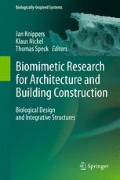Abstract
Within biomimetics, scientists are challenged by the interdisciplinary exchange of knowledge and concepts, which include functional principles in complex systems of biological organisms, buildings and machines. One concept, that is used in biology as well as in architecture and in engineering, is the concept of the “organism”. Despite representing the primary hierarchical level on which morphological form and functionality interact, the individual organism, as a functional unit, has been increasingly neglected within modern biology. A similar trend can be recognized within modern architecture: as an integral concept, the built form has been lost from view. This article raises the question as to how the term “organism” and its function in the discourse of architecture can be conceptualized and possibly used as a unifying concept in interdisciplinary biomimetic research. While in biology, the “organism” is a more or less well defined concept to denote living entities, in an architectural sense, it functions as a model or topos, i.e. a commonly plausible semantic form that is usually not explicitly stated, but still becomes operative in establishing form decisions. As a case example, in this contribution, the focus is on the use of the “organism” in the German Romantic discourse of architecture and aesthetics, namely in the writings of Schelling and in Schinkel’s architectural designs. Thereby, it becomes apparent how a scientific term can be transferred into a model for designing buildings.
Access this chapter
Tax calculation will be finalised at checkout
Purchases are for personal use only
References
Bateson G (1972) Steps to an ecology of mind. Collected essays in anthropology, psychiatry, evolution, and epistemology. Jason Aronson, Northvale/London
Behne A (1926) Der moderne Zweckbau. Drei Masken Verlag, Berlin
Blümle C, Schäfer A (2007) Organismus und Kunstwerk. Zur Einführung. In: Blümle C, Schäfer A (eds) Struktur, Figur, Kontur. Abstraktion in Kunst und Lebenswissenschaften. Diaphanes, Berlin, pp 9–25
Campbell NA, Reece JB (2009) Biologie. Pearson Studium, München
Caplan AL (1987) Why the problem of reductionism in biological science will not go away. Growth 51:22–34
Drack M, Pouvreau D (2015) On the history of Ludwig von Bertalanffy’s “General systemology”, and on its relationship to cybernetics – Part III: convergences and divergences. Int J Gen Syst 44:523–571
Gegenbaur C (1870) Grundzüge der vergleichenden Anatomie. W. Engelmann, Leipzig
Guillén MF (2006) The taylorized beauty of the mechanical: scientific management and the rise of modernist architecture. Princeton University Press, Princeton/Oxford
Homberger DG (1988) Models and tests in functional morphology: the significance of description and integration. Am Zool 28:217–229
Karr JR, James FC (1975) Eco-morphological configurations and convergent evolution in species and communities. In: Cody ML, Diamond JM (eds) Ecology and evolution of communities. Belknap, Cambridge, MA, pp 258–291
Laubichler MD (2005) Systemtheoretische Organismuskonzeptionen. In: Krohs U, Toepfer G (eds) Philosophie der Biologie. Suhrkamp, Frankfurt am Main, pp 109–124
Limpinsel M (2016) Was macht Wissen plausibel? Topische Objektkonstitution in den Geisteswissenschaften. In: Kämper H, Warnke IH, Schmidt-Brücken D (eds) Textuelle Historizität. Interdisziplinäre Perspektiven auf das historische Apriori (Discourse Patterns 12). De Gruyter, Berlin/Boston, pp 105–121
Maier W (1999) On the evolutionary biology of early mammals – with methodological remarks on the interaction between ontogenetic adaption and phylogenetic transformation. Zool Anz 238:55–74
Motta PJ, Kotrschal KM (1992) Correlative, experimental, and comparative evolutionary approaches in ecomorphology. Neth J Zool 43(2–3):400–415
Nachtigall W (2010) Bionik als Wissenschaft: Erkennen – Abstrahieren – Umsetzen. Springer, Berlin
Nönnig JR (2007) Architektur. Sprache. Komplexität. Acht Essays zur Architekturepistemologie. Bauhaus Universität, Weimar
Perelman C, Olbrechts-Tyteca L (2004) Die neue Rhetorik. Eine Abhandlung über das Argumentieren. Ed. Josef Kopperschmidt, problemata, Bd. 149, Stuttgart-Bad Cannstatt
Perret A (1952) Contribution à une théorie de l’architecture. Cercle d’études architecturales, Paris
Plato (1981) Werke in acht Bänden. Ed. Gunther Eigler. Bd. 5, Phaidros. Parmenides. Briefe. Wissenschaftliche Buchgesellschaft, Darmstadt.
Reilly SM, Wainwright PC (1994) Conclusion: ecological morphology and the power of integration. In: Wainwright PC, Reilly SM (eds) Ecological morphology. The University of Chicago Press, Chicago/London, pp 339–354
Riedl R (2000) Strukturen der Komplexität. Eine Morphologie des Erkennens und Erklärens. Springer, Berlin
Ripley RL, Bhushan B (2016) Bioarchitecture: bioinspired art and architecture—a perspective. Phil Trans R Soc A 374
Sauer KP (1992) Morphologie und Evolution. Verh Dtsch Zool Ges 85(2):349–357
Schinkel KF (1979) Das architektonische Lehrbuch. Ed. Goerd Peschken. Deutscher Kunstverlag. Berlin
Thaler L (1984) Organische Form in der Musiktheorie des 19. und beginnenden 20. Jahrhunderts. Musikverlag Emil Katzbichler, München.
Toepfer G (2011) Organismus. In: Toepfer G (ed) Historisches Wörterbuch der Biologie. Geschichte und Theorie der biologischen Grundbegriffe. Metzler, Stuttgart
van Eck C (1994) Organicism in nineteenth-century architecture. An inquiry into its theoretical and philosophical background. Architectura & Natura Press, Amsterdam
Vincent JFC (2014) An ontology of biomimetics. In: Goel AK et al (eds) Biologically inspired design. Springer, London
Wiener N (1948) Cybernetics, or control and communication in the animal and the machine. MIT Press, Cambridge, MA
Zoglauer, T (1994) Modellübertagungen als Mittel interdisziplinärer Forschung. In: Maier W, Zoglauer T (eds) Technomorphe Organismuskonzepte. Modellübertragungen zwischen Biologie und Technik. problemata 128, frommann-holzboog, Stuttgart, pp 12–24
Acknowledgements
This work has been funded by the German Research Foundation (DFG) as part of the Transregional Collaborative Research Centre (SFB/Transregio) 141 ‘Biological Design and Integrative Structures’, project C02 ‘Organism concepts in biology and architecture as the basis for an interdisciplinary synopsis of constructional biomimetics.’
Author information
Authors and Affiliations
Corresponding author
Editor information
Editors and Affiliations
Rights and permissions
Copyright information
© 2016 Springer International Publishing Switzerland
About this chapter
Cite this chapter
de Bruyn, G., Betz, O., Nebelsick, J.H., Drack, M., Limpinsel, M. (2016). Making Life “Visible”: Organism Concepts in Biology and Architecture as the Basis for an Interdisciplinary Synopsis of Constructional Biomimetics. In: Knippers, J., Nickel, K., Speck, T. (eds) Biomimetic Research for Architecture and Building Construction. Biologically-Inspired Systems, vol 8. Springer, Cham. https://doi.org/10.1007/978-3-319-46374-2_19
Download citation
DOI: https://doi.org/10.1007/978-3-319-46374-2_19
Published:
Publisher Name: Springer, Cham
Print ISBN: 978-3-319-46372-8
Online ISBN: 978-3-319-46374-2
eBook Packages: Biomedical and Life SciencesBiomedical and Life Sciences (R0)

